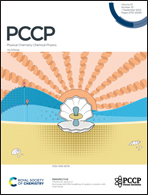Possible handle for broadening the catalysis regime towards low temperatures: proof of concept and mechanistic studies with CO oxidation on surface modified Pd–TiO2†
Abstract
The present work demonstrates the effect of temperature-dependent surface modification (SM) treatment and its influence in broadening the catalysis regime with Pd–TiO2 catalysts prepared by various methods. Due to SM induced changes, a shift in the onset of CO oxidation activity as well as broadening of the oxidation catalysis regime by 30 to 65 K to lower temperatures is observed compared to the temperature required for virgin counterparts. SM carried out at 523 K for PdPhoto–TiO2 exhibits the lowest onset (10% CO2 production – T10) and T100 for CO oxidation at 360 and 392 K, respectively, while its virgin counterpart shows T10 and T100 at 393 and 433 K, respectively. The SMd Pd–TiO2 catalysts were investigated using X-ray photoelectron spectroscopy (XPS), ultra-violet photoelectron spectroscopy (UPS) and atomic force microscopy (AFM). It is observed that diffusion of atomic oxygen into Pd-subsurfaces leads to SM and changes the nature of the surface significantly. These changes are demonstrated by work function (ϕ), surface potential, catalytic activity, and correlation among them. UPS results demonstrate the maximum increase in ϕ by 0.5 eV for PdPhoto–TiO2 after SM, compared to all other catalysts. XPS study shows a moderate to severe change in the oxidation states of Pd due to atomic oxygen diffusion into the subsurface layers of Pd. Kelvin probe force microscopy (KPFM) study also reveals corroborating evidence that the surface potential increases linearly with increasing temperature deployed for SM up to 523 K, followed by a marginal decrease at 573 K. The ϕ measured by KPFM and UPS shows a similar trend and correlates well with the changes in catalysis observed. Our results indicate that there is a strong correlation between surface physical and chemical properties, and ϕ changes could be considered as a global marker for chemical reactivity.



 Please wait while we load your content...
Please wait while we load your content...